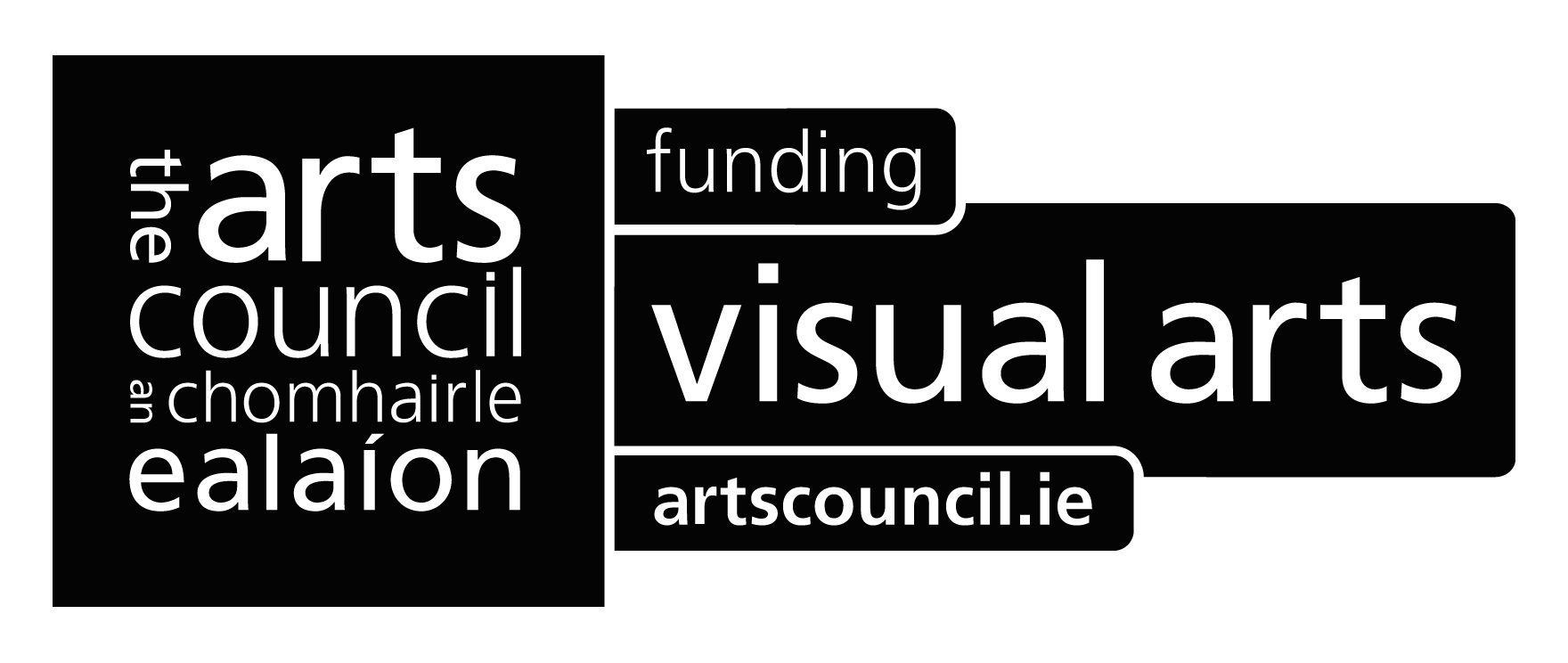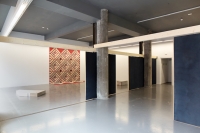staring forms
Temple Bar Gallery + Studios
Friday 3 May - Friday 28 June 2019
Miranda Blennerhassett, Aleana Egan,
Andreas Kindler von Knobloch, Tanad Williams

Staring forms is a group exhibition that brings together four individual artistic practices that engage with space, interiors and sites using distinct voices and methodologies. The exhibition takes as its starting points the structures, ornamentation and navigation of internal domestic and public space. These ideas were developed through discussions around a collection of shared texts, selected by each artist in response to the initial exhibition proposal, that resonate with their distinct practices.
The texts, which include critical, philosophical and political essays, fiction and poetry, give an insight into each artist’s approach to research, and provide a broader frame of reference for the exhibition. Frequent individual and group studio visits invited further conversation and reflection between the artists at all stages of development and, as a result, this exhibition has been guided by the shared sensibilities of the four singular practitioners.
One of the key early phrases that sparked discussion is a passage from T. S. Eliot’s ‘The Waste Land’, which gives agency to the decorative features of the poem’s setting as witnesses to the events unfolding in the room:
And other withered stumps of time
Were told upon the walls; staring forms
Leaned out, leaning, hushing the room enclosed.
The draft manuscript of ‘The Waste Land’ vigorously annotated by Ezra Pound and Vivienne Haigh-Wood Eliot, became a further visual and conceptual guide for the exhibition. The prominent redactions, notation and meticulous edits of the poem call attention to the written word as a visual form. The structural reconfigurations of the work, heightened by the agitated combination of Eliot’s mechanical typed text with Pound and Haigh-Wood Eliot’s pencil annotations, relate to the architectural modifications proposed by the artists for the exhibition.
The compatibility of materials informs a crucial equilibrium throughout staring forms. Each artist uses idiosyncratic combinations of industrial construction materials with hand-worked techniques and components. The conversation between different materials and processes speaks both to the familiar and comforting interiors of rooms as well as the robust structures that contain them. This spatial discussion invites consideration of the internal mindset of the artists’ creative processes in relation to the world in which these ideas inhabit. The internal dream and external reality is a dialogue assuredly conveyed in Marion Milner’s book ‘On Not Being Able To Paint’:
I could tell myself that we cannot help but dream, completing in imagination the pattern of our necessarily fragmentary experiences of the external world, we cannot help working over in our imagination what happens to us, creating internally the ideal wholeness of what the experience might have been; just as we continually complete the wholeness of the unseen three sides of a cube and recognise it as a solid in our everyday experience of perceptions.
Miranda Blennerhassett most often produces her works directly on to the existing architectural structures and features of specific exhibition sites. Through wall-paintings, she applies the repetition, ornamentation and patterning of weaving and textile design to soften the rigidity and density of buildings and their construction. Her work in staring forms utilises the iconic ‘log cabin’ quilting pattern that became popular in the USA during the mid-19th century. The centre of this pattern traditionally incorporates a red square to symbolise a hearth, with light and dark strips at each side representing sunlight shining in to the room. In this new work, Blennerhassett has incorporated upholstery textiles over the painted wall and floor surfaces to convey a sense of warmth and to evoke the use of fabric in domestic environments and make reference to the history of quilt making, and the communal activity of shared creative female labour.
Aleana Egan’s work frequently draws on the atmosphere and tonality of early to mid-20th century literature, design, and cultural iconography. By immersing herself within these worlds, Egan’s resulting sculptures and assemblages echo particular moods and hint at untold narratives with reverberant tangibility. The garments that Egan has consistently incorporated in her installations for many years hold a residue of specific times, places, cultures and the human physical form. Egan is interested in the element of craft and hand-work in these articles. They embody a particular sensibility of personal refinement in their assembly during an age before mass-produced clothing became the convention. Egan has also produced a new installation for the Atrium space that links the public gallery to the private artist studios above, inviting further exploration of interior spaces, with visual and auditory signals that alter the perception of the environment.
Andreas Kindler von Knobloch and Tanad Williams share an enduring and industrious collaborative practice, but have concentrated their energies on individual research areas to produce separate site-responsive works in staring forms. Their sculptural installations and interventions play with scale and accessibility, hinting at the imaginative potential within existing architectural structures and exploring new ways of navigating the world through the built environment. The two artists both sustain ecologically and socially minded practices, often producing installations that have a functional and communal role. For example, on a 2018 residency in rural Japan, the artists constructed a traditional bath-house to be used by future visitors to the otherwise isolated community.
Influenced by this residency, Kindler von Knobloch’s works in the exhibition are inspired by traditional Japanese sliding panel doors, mounted on large timber beams that bisect the gallery, using the industrial steel and concrete pillars as supports. The panels are coated in light sensitive cyanotype solution, historically used in the reproduction of architectural blueprints, and are freely moveable by visitors. Obscuring and revealing views of the gallery space and artworks, encourages contemplative looking and exploration, as well as controlling the movement and flow of people through the exhibition area. The juxtaposition of craft aesthetics and infrastructural engineering shows a duality of human attitudes towards communal work and recreation environments.
Williams continues his engagement with surfaces, implementing standard building and construction materials to replicate the textures and geological strata. The patterns and finishes of bespoke domestic interior decoration (such as marble countertops) combined with the increasingly specialized culture of hand-craftsmanship (stone carvers, glaziers, weavers), are echoed in Williams’ parquet floor/tectonic plate inspired sculptures. His use of man-made plastic-based materials (foam, resin) is pertinent to the discovery of newest layer in the geological record, ‘Plastiglomerate’ (the name given to the agglomerate of used-plastic debris with natural materials that is forming over the parts of the Earth’s surface). Williams calls attention to the ecological issues of artistic practice in the context of climate catastrophe, and the world beyond the interior.
Each of the four artists is either a current or previous studio member at Temple Bar Gallery + Studios:
Aleana Egan | Membership Studio (2018–2021), Miranda Blennerhassett | Membership Studio (2015–2018), Andreas Kindler von Knobloch and Tanad Williams | Project Studio (2017).
In the spirit of this exhibition, we have opened up and made visible some small, previously hidden, architectural features of our gallery and upper atrium areas.
This exhibition features as part of the Building Stories programme in the Dublin International Literature Festival 2019.








